Panoramic interpretation of the Web3 music track: market background, commercial value, outbreak path and investment opportunities
Research Institution: Mint Ventures
Researcher: Xu Xiaopeng
Researcher: Xu Xiaopeng
opinion summary
Co-author: Huang Minqiang
opinion summary
Music is a global market with an annual revenue of 20 billion US dollars, and the dominance of the industry is gradually shifting from record companies holding copyrights to online music platforms
The Web3 music industry does not have the conditions for an outbreak similar to DeFi for the time being. It still needs to look forward to the maturity of the user base and community concept, but the technical preparations are relatively mature.
text
It is difficult for music NFTs to reproduce the popularity of avatar NFTs. The explosion path of Web3 music projects can refer to the business flywheel model of DeFi
text
In this track insight, we focus on the Web3 music track.
Since the explosion of the DeFi track in 2020, encrypted business has ushered in the first group of users other than investors: financial customers. With the popularity of the NFT concept in 2021, the wave of Web3 applications has begun to spread to fields other than finance, and the NFT collectibles boom and the summer of chain games have been staged one after another. With the "proof of commercialization" of DeFi applications, and the expansion of NFT collections and blockchain games to the encrypted population, the "creator economy" has slowly launched a new wave of Web3 narrative trends at the end of 2021.
And Web3 music is just a subdivision track in the "creator economy". In addition, music, as an important category of NFT collections, can also be classified as a key category under the NFT tide.
From the perspective of Web3 business, the music track has a huge two-sided market: creators & consumers; from a technical perspective, NFT, L1+ blockchain data storage (Arweave, Filecoin) and other technical applications are gradually maturing; from a narrative perspective, music The track has the double blessing of NFT collection + creator economy.
2021 can be said to be the first year of the Web3 music track, will 2022 be its year of opportunity?
In this article, we ponder and try to answer the following questions:
What is the background of the music market corresponding to the Web3 music track?
How to define a Web3 music project? What problems does it and music NFT solve in the existing music industry?
How will the Web3 music track explode?
How to capture the investment opportunities
first level title
1. Status quo and business model of the music industry
1.1. Participants and changes in the music industry
Music is a huge industry, with IP parties and user groups no less than social and game volume. This market has relatively clear supply and demand ends. On the supply side are musicians or record companies, entertainment or brokerage groups that have signed a large number of musicians; on the demand side are music consumers. Among them are ordinary music lovers. There are also rabid fans or fans.
Music has a long history of commercial development, and its transmission media range from live band performances, to gramophones, to radio, television, and digital media such as vinyl records, tapes, CDs, MP3s, etc., until now the streaming music platform, every A change in the music media will bring about changes in the industry.
In the past, the record company was the party with the strongest voice in the industry. It mastered the discovery and packaging of singers, the production and promotion of music, the distribution of records and the operation of concerts, etc., and they also accounted for the bulk of royalties. In addition, record companies also hold a large number of high-quality music copyrights. However, with the emergence of the Internet, the advantages of music production and publicity that record companies once firmly controlled are no longer obvious, and music promotion channels have shifted from centralized media to social media. The maturity of digital technology has reduced the cost of music creation, and more and more people have embarked on the road of music creation. They produce and distribute their own music with a faster rhythm and a shorter path.
Online music platforms have become a new intermediary between listeners and musicians. They are not only responsible for music promotion, distribution, recommendation and income settlement, but also vigorously develop upstream, focusing on cultivating new musicians and original music, and music platforms. The number of signed musicians continues to rise. The blowout of new original music, on the one hand, satisfies the changing music tastes and desire for new content of music consumers in the Z era, and on the other hand, it also provides online music platforms with bargaining chips in the copyright game with traditional record companies.
After sorting out the current music industry environment, before we start specific market analysis, we still need to think about an important question: In this era, what kind of commodity is music? All business logic is based on this question, and all industrial structures are based on this question.
Zhong Wen, the author of the official account "Pinwan", once had a classic description of this:
"…No matter what scene or form it is in, the core attributes of music will not change—music is a way for us to empathize with the world, a language that transcends time, space and culture.
This is perhaps the most 'sexy' thing about the music industry. In any era and in any civilization, we all need music and are all moved by similar rhythms. "
Pinwan: "Online music paying users exceed 71 million, TME pushes the flywheel of the music industry"
As a spiritual consumer product that "empathizes with the world", music has stronger repeat consumption attributes than books, movies, and dramas. Even the most novelty-loving listener will have treasured music played hundreds of times in his player. Once people find a certain song they like, the stickiness it produces is dozens of times that of other content products.
Regarding the music industry, we can make a preliminary summary:
The main players in the music industry include musicians (lyricists, singers, etc.), record companies, music platforms, and music consumers
Internet music platforms have replaced traditional record companies as the new giants of the industry. They have mastered the core links of music promotion, distribution, and settlement, and are expanding upstream to content, directly cultivating musicians and producing original music.
1.2. Market size of the music track
Next, we will observe the size of the current music market from three dimensions: market revenue, consumers and musicians.
1.2.1. Revenue scale
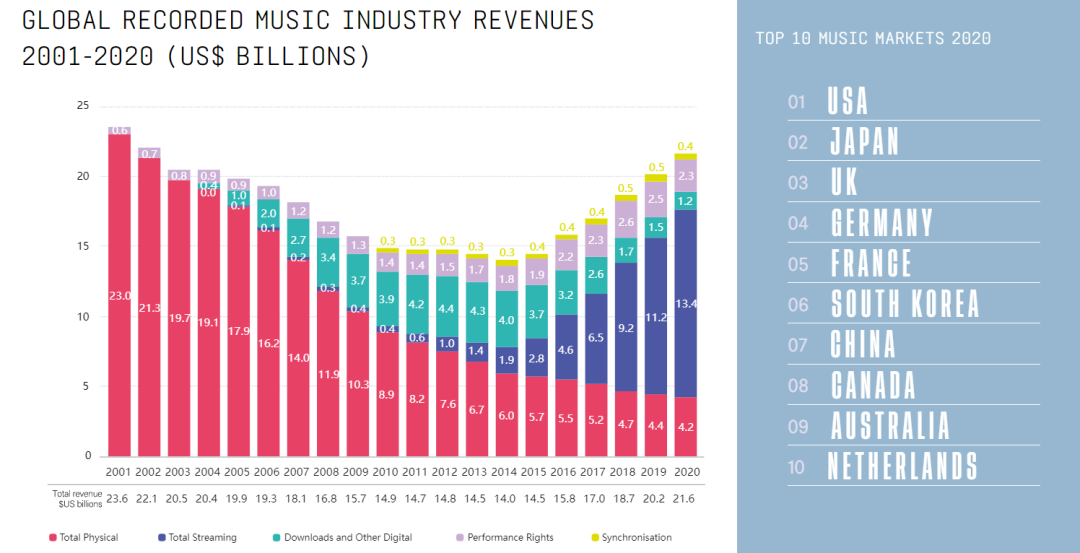
According to the 2021 annual report released by the International Federation of the Phonographic Industry (IPFI), the total revenue of the global recorded music market in 2020 will be US$21.6 billion. Since the bottom in 2014 (14 billion US dollars), it has been growing positively for 6 consecutive years, but it has not surpassed the high point in 2001.
Data source: "International Music Market Report: 2021" https://gmr2021.ifpi.org/report
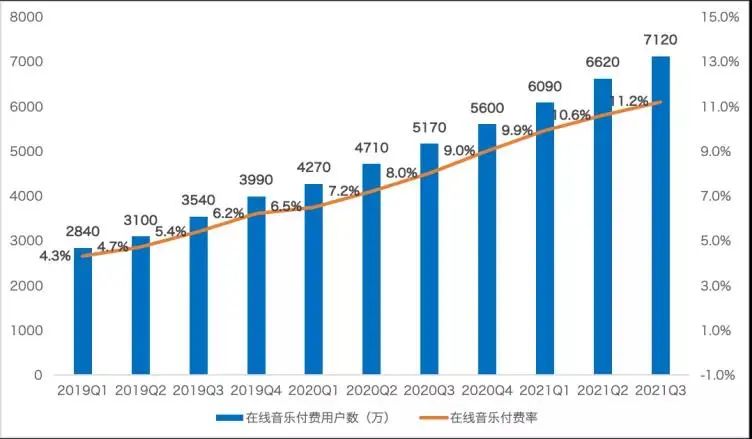
Among them, the United States, Japan, the United Kingdom, Germany, and France rank among the top five music consumption countries, and China ranks seventh, second only to South Korea. Although China has the highest internet population in the world, its proportion of paying users for music is much lower than that of the West. According to the 2021 third-quarter financial report disclosed by Tencent Music Entertainment Group (TME), which has the largest number of users and revenue in China, its online music paying users reached 71.2 million, accounting for 11.2%. The value (payment per user per month) is 8.9 yuan (rmb).
image description
Data source: TME 2021 Q2 financial report
In terms of sources of music revenue, revenue from online music accounts for 62% of the total global music revenue, and this part of revenue has increased by as much as 19.9% year-on-year, while other sources include physical sales (physical records, etc.), downloads and other digital revenues, Income from performances and related copyrights and music licensing will all decline month-on-month in 2020 (affected by the epidemic).
Through the above data, we can find that music is a global market worth 20 billion US dollars. Online music platforms represented by Spotify and Tencent Music (its products include QQ Music, Kugou Music, and Kuwo Music) have promoted the recovery of the music market that has been sluggish since 2001. "Online music platforms pay musicians based on the number of plays" has become the most mainstream music business model, namely the "streaming media music platform model".
1.2.2. Scale of paying users
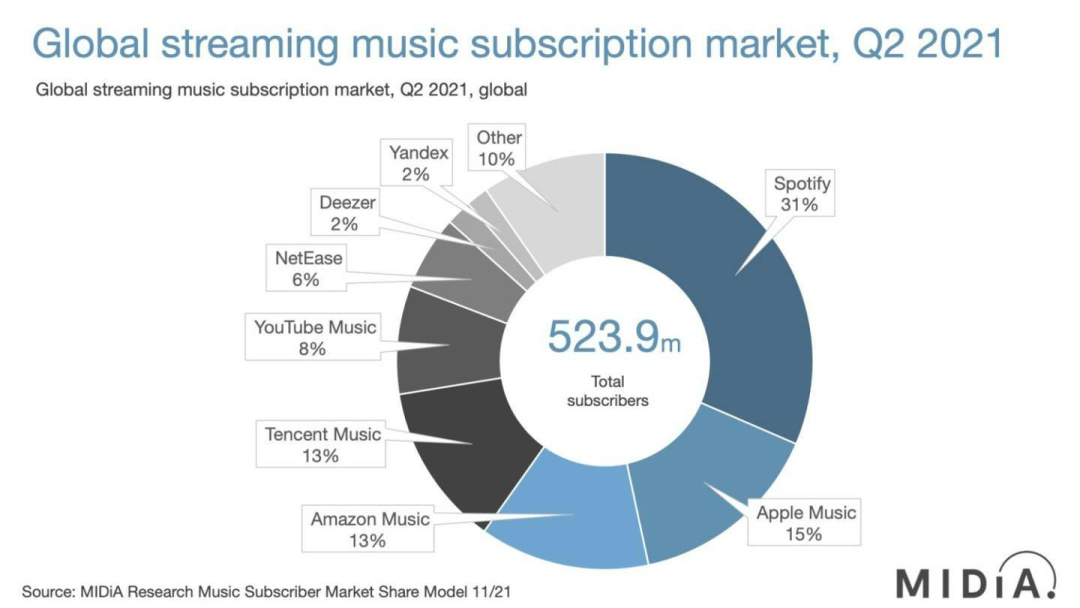
According to data released by the research organization MIDiA Research, in the second quarter of 2021, the total number of subscribers to streaming music reached 523.9 million, an increase of 26.4% over the same period in 2020. Spotify is still the platform with the largest number of subscribers.
Data source: MIDiA Research
Of course, music users are not limited to paying users of online music platforms, but also include consumers of physical records, concert audiences, consumers around musicians, music authorized buyers (such as advertisers), and so on. However, most of these users also overlap with streaming music users.
text1.2.3. The scale of musicians
Combining the above data, we can conservatively estimate that the total number of musicians in the world should be more than 10 million.

image description
Comparison of income of Chinese musicians in 2019-2020
image description
Source: "Report on Chinese Musicians: 2021", Communication University of China
Copyright is the core business logic of the music market, and the complete rights of a song can usually be divided into four parts: the copyright of words/songs, the copyright of recordings, and the performance rights of singers. The above four parties enjoy the royalties (that is, copyright royalties) after the song is released, and other personnel, such as producers, arrangers, musicians, etc., enjoy a one-time settlement.
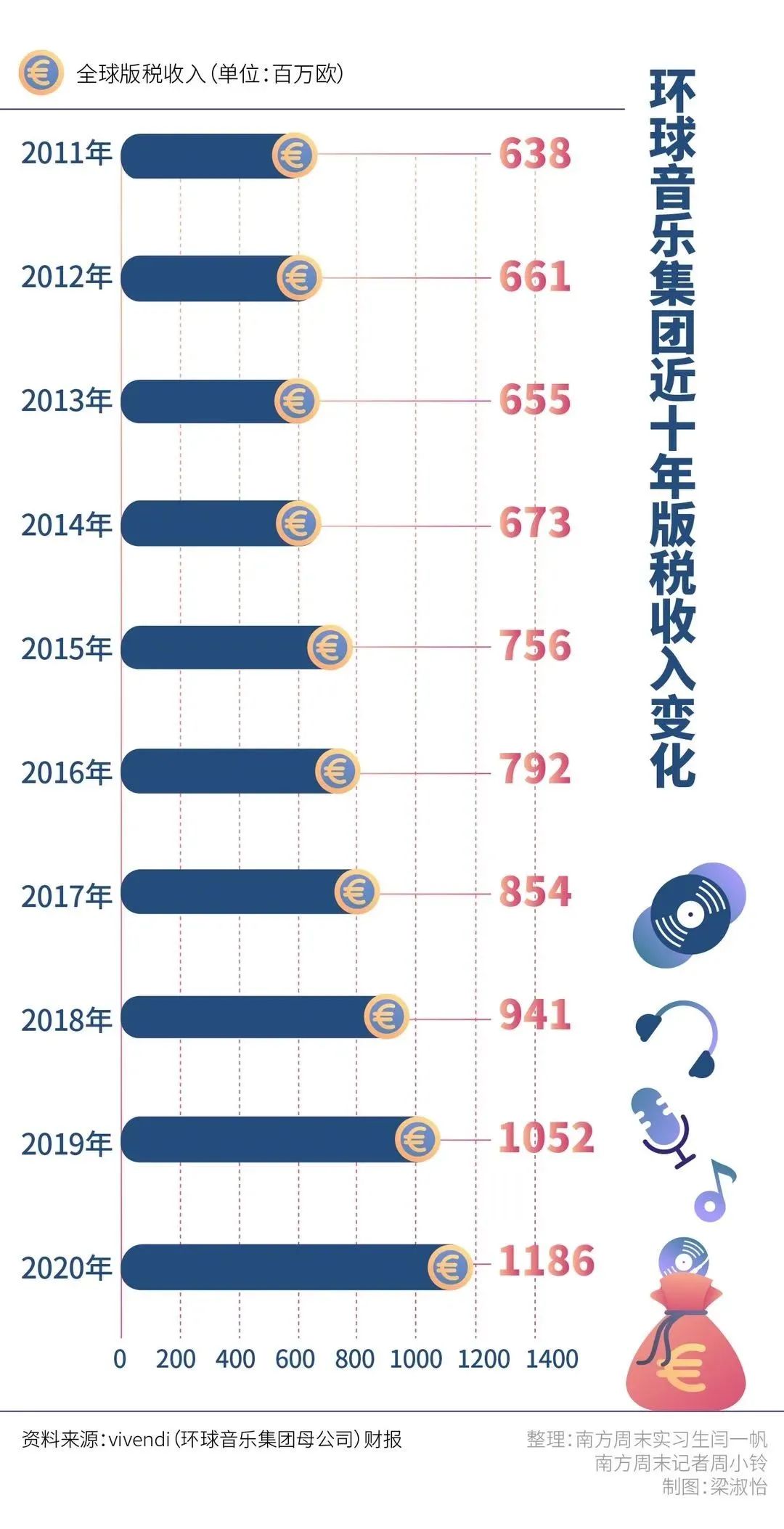
Historically, major labels have been at the heart of music production, scouting out singers, songwriters and professional teams. They also have the strongest discourse power, possessing the performance rights of singers and recording copyrights (master tapes), and at the same time, their copyright companies represent the copyrights of lyrics and music. As small record companies were acquired by large record companies, music rights were concentrated in the hands of a few large companies. Its revenue also accounts for a large part of the industry's revenue. For example, the copyright revenue of Vivendi, the parent company of Universal Music, reached 1.186 billion euros in 2020, and it is still growing.
image description
Image: Southern Weekend
However, with the rise of online music platforms, the number of original singers with relatively free identities is also increasing, and strong IP artists have built their own studios, and musicians are gradually getting rid of the control of record companies.
Whether it is an original musician or a record company, online music platforms are one of their core sources of copyright income.
On the online music platform, the settlement with the copyright owner is usually based on the number of songs played. Take Spotify as an example:
Spotify mainly makes money in two ways: Spotify's paid subscription revenue and advertising on Spotify's free version. About 2/3 of this money will be paid to music copyright owners. Spotify divides the royalty pool based on each copyright owner's "traffic share" on Spotify, but does not pay a fixed fee for "per stream"-that is, the amount played (per stream).
Because paying subscribers do not pay by the amount of playback, but pay a fixed membership fee.
Each month in each country where it launches, Spotify adds up the rights holders' music streams and divides by the total streams in that market to arrive at a share of traffic, which is used to allocate the region's revenue. music income.
For example, if the overall streaming volume in the Mexican market is 1,000, and the playback volume of a certain musician's work in this region is 1, then his income will be 1/1,000 of the entire royalty pool in the Mexican market. The total royalty pool for each country, based on user paid subscription revenue and advertising revenue in that market.
This means that the income of each musician from the online music platform is affected by three core factors: the total income of the online music platform, the playback volume of the musician's works and the playback volume of other musicians' works.
Of course, in addition to streaming income from streaming media platforms, musicians’ sources of income also include: offline/online performances, direct sales or downloads of digital albums, music licensing fees (movies, commercials, variety shows, etc.) Sale. However, the proportion of income in these parts is either not high, or the proportion is gradually decreasing.
1.4. Summary
Through the content of this chapter, we can make the following summary of the current music industry:
The commercial essence of music is to provide listeners with a way to empathize with the world, and it is also the content product with the highest repeat consumption rate and the most sticky content
Music is a 20 billion+ US dollar market, of which the revenue accounts for the bulk and the fastest growth is the online music platform
The core business model of this industry is copyright. At present, the overall income of musicians is not high, which is determined by the increasingly fierce market competition and the industrial structure dominated by Internet platforms.
The above is also the market background faced by the Web3 music track, and it is this environment that gave birth to its value and business logic.
first level title
2. The value of the Web3 music project
2.1 Define the Web3 music track
The so-called Web3 music track refers to the overall music industry chain based on the Web3 paradigm. Its characteristics mainly include:
The core service protocol is built and run on blockchain
Digital music assets are issued and circulated based on blockchain and decentralized storage technology
In terms of value distribution, it has the characteristics of disintermediation and transparency
So, what problems and new opportunities can Web3 music projects and music NFTs with the above characteristics solve?
2.2. Problems that the Web3 Music Project tries to solve
text
2.2.1.Web3 cannot solve the income problem of the overall musicians in the short term
When it comes to the Web3 music track, or the value of music NFT, we often hear a point of view: musicians can use NFT as a music carrier to sell directly to Ta's fans, avoiding the pressure of record companies and online music platforms. Layers of exploitation, in order to increase the income of musicians.
However, the author believes that the Web3 music wave does not mean that the income of musicians as a whole can be improved in the short term. In the short term, it only provides them with more transparent and diverse channels and value distribution tools.
That is to say, on the supply side: due to the rapid reduction in the cost of music production in the digital age, ordinary people can also create and distribute music, and the number of new music works is increasing rapidly; on the demand side: the content consumption time of the total population has an obvious ceiling, and this Part of the time, it also faces competition from cross-field competitors such as video games, online videos, and social tools.
Under such circumstances, the unlimited supply of music works is faced with increasingly scarce entertainment time and attention, and most of the music is reduced to "zombie works" that no one cares about and few clicks, which is the inevitable fate under the cruel market competition . The NFTization of Web3 and music media cannot change this fact, just as DeFi can create a more equal, open, and innovative financial environment, but it cannot make all users rich.
text
2.2.2. The value of Web music and NFT: reshaping value distribution, infrastructure for future music services
So what are the positive changes brought about by the introduction of Web3 and NFT to the music industry?
I think there are two main things:
Compared with traditional digital music that only has "listening value", music works based on NFT have new attributes of programmable, traceable, combinable, and tradable, so that a new music service model that is currently unimaginable can be derived and scene
To put it simply: reshaping the value distribution of the music industry, endowing music with new value connotations "beyond listening to songs", and making technical, commercial and conceptual preparations for the next upgrade of the music industry.
text
2.2.2.1. Reshape value distribution
The so-called "reshaping value distribution" mainly refers to:
Improve the transparency and convenience of income distribution and improve the symmetry of information
Provide musicians with fewer intermediaries, shorter music distribution channels and a new transaction-based royalty scheme
Users can also be included in the value distribution system
Specifically:
a. Improve the transparency and convenience of income distribution
In the existing recording industry, the online copyright revenue of a song has multiple directions. Published in the well-known Chinese media "Southern Weekend" in 2021, "Ten Years of Copyright War: Prices have increased by nearly a thousand times, has the music become better?" "In the report, the lyricist Wu Xiangfei said:
"On the music playback platform, 42% of a song's revenue is distributed to the record company, about 30% is distributed to the operating system (such as Android, iOS, etc.), and about 20% is distributed to the Internet playback platform. to 8%, and singers are mostly settled by record companies.” Usually, Internet platforms will provide detailed song playback data to copyright companies, and copyright companies will then provide songwriters with their personal playback data details and royalty reports, but songwriters are very It is difficult to verify these data reports. Because "the cost of rights protection is high, and the voice of musicians is low, so they can only bear it silently."
Wu Xiangfei also said:
"Different copyright companies offer different quotations to creators, and the pricing power is in the hands of the companies... The copyright royalties for the same song and the same year provided by the two copyright agencies differ by 195 times."
b. Provide distribution channels with fewer intermediaries and shorter links and new royalty schemes
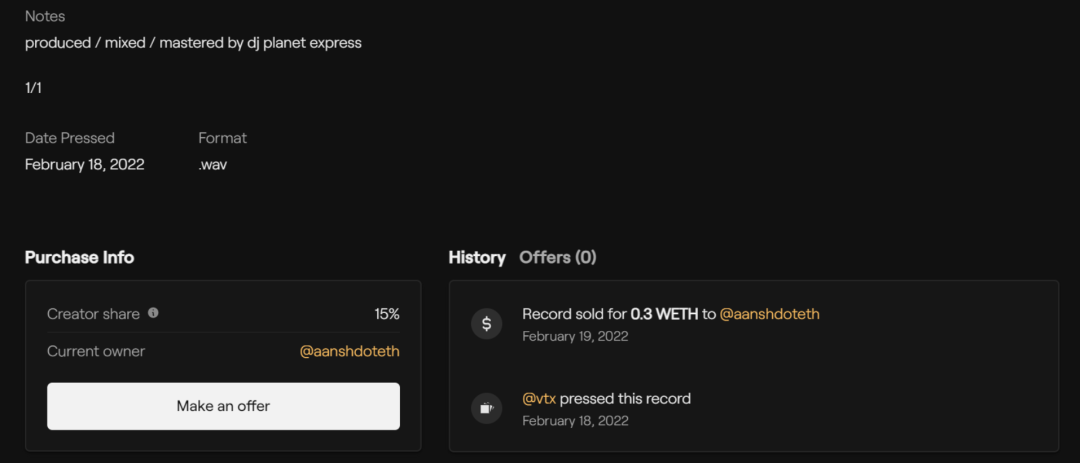
Music NFT display and sales platforms such as Catalog, Sound.xyz, Nina, etc. provide musicians with a new distribution channel for their works. Musicians can make their music works into NFT through the platform, and sell them through auction or directly to single or multiple music collector. In addition, musicians can also set NFT transfer royalties, and each time the NFT is resold, they can get a certain percentage of the resale amount of royalties.
image description
Music NFT details on the Catalog, you can see the holder of the current work, issue price, resale royalty rate, etc.
Traditional digital music copies and audio streams can only be used for playback, which is a right to use, while music in the form of NFT represents a kind of ownership, and even this ownership can be directly linked to the copyright of the music, so that NFT buyers can also participate and obtain copyright benefits. The Web3 music platform Royal is designed in this way. When a user purchases a musician's NFT, he will own a part of the music's streaming revenue.
Combining the above points, we can regard Web3 music as an innovation of "production relations", and NFT is its technical carrier.
text
2.2.2.2. Activation of new music services and scenes
In addition to the key role in value distribution, the longer-term role of Web3 music and NFT may lie in opening up new service categories and new scenarios that do not currently exist through the new properties of NFT music, which are programmable, traceable, combinable, and tradable , stimulate product and service innovation on a broader level, and directly increase the output value of the entire industry.
For example, music event organization Live Nation recently announced the launch of the Live Stubs project, which will allow fans to receive an exclusive numbered concert NFT for free when purchasing concert tickets. Michael Rapino, CEO of Live Nation, explained: "Our Live Stubs product evokes nostalgia for the days when fans collected concert ticket stubs, while giving musicians a new tool to deepen their relationship with their fans. Can't wait to see the creativity and future prospects of this community."
Although Live Nation has not disclosed the specific use of the concert "ticket stub NFT", we can make some reasonable imaginations that this NFT can be used for:
Exclusive pass to access the official fan club or DAO
Access special backstage footage of this concert
As a fan credential, accept airdrops of fan tokens issued by singers
……
Used as a blind box, other rights and interests provided by the singer can be extracted, such as front row seats for the next concert, backstage access, etc.
In addition, based on the programmability of NFT, musicians can open the use and mixing rights of music NFT, and other musicians can purchase the copyright remix of original music and cast it into new music. async.art is providing the above services.
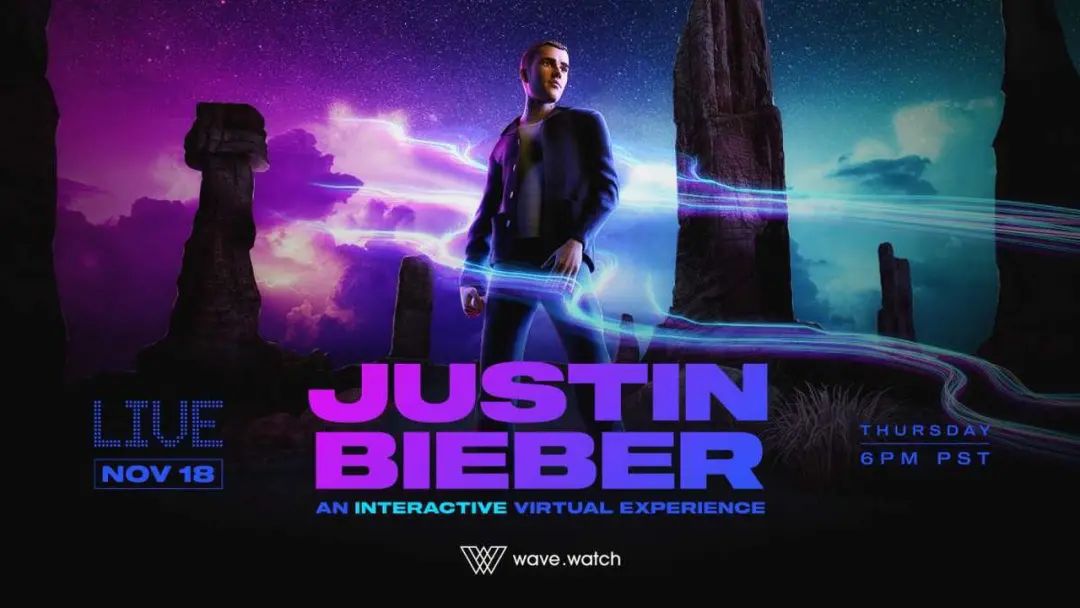
I have to admit that the above imagination is still lacking and limited, and truly great innovations are often beyond our current cognition. Just as music fans sitting in a concert hall and indulging in live performances of classical bands a hundred years ago could not have imagined that now we can pay to participate in online live concerts of singers, and even attend Justin Bieber’s music festival in the Metaverse with a virtual ID. At present, we cannot accurately predict what new services the Web3 music industry will have.
image description
On November 18 last year, Justin Bieber opened a "Metaverse Concert" based on motion capture technology and the virtual concert company Wave VR.
But we can be sure that:
The type of music service based on Web3 must be richer, more diverse and more exciting than the current Web2 music service
In the blockchain-based metaverse, NFT may be the main format of music
To sum up, in the short term, the Web3 music project can provide a brand-new value distribution scheme, make the value distribution of the music industry more transparent and fair, and gradually transform consumers into right holders; in the long run, the new paradigm of Web3 can To activate a new type of music service, NFT may also be the mainstream music carrier in the future.
However, there are still many prerequisites for Web3 music applications to really become popular.
first level title
3. The prerequisite for the rise of the Web3 music track
3.1. User Level: User Difficulties for Web3 Music, Social and Game Projects
Although the Web3 music track has a bright future in the long run, we need to realize that Web3 music, social and game applications are very different from DeFi, and we cannot simply copy the success of DeFi business to these fields.
Blockchain and Bitcoin were financial applications at the beginning of their creation. The original intention of Satoshi Nakamoto to design Bitcoin was to provide a decentralized payment system. Even in the earliest days of Bitcoin and blockchain, every public chain Behind the addresses are users driven by financial motives, whether they come because they recognize the concept of decentralized finance, or come purely for speculative purposes.
It is precisely because of this that the promotion and development of DeFi applications based on Ethereum smart contracts will be so fast, because they meet the financial needs of users.
We can also see the reality that "user needs in the encrypted world are dominated by financial needs" from the development process of the chain game field.
From 2018 to 2019, we have witnessed a wave of blockchain games. The concept at that time was "to make games based on blockchain". In the end, the life cycle of this wave was very short, and it hastily receded. The only impressive thing is the large number of Gambling applications and speculative projects such as FOMO3D (in line with the speculative nature of financial users).
In short, in the encrypted world dominated by financial users, currently only financial-related applications are easy to succeed. Pure music, social networking, and games want to find their user groups here, which is far more difficult than DeFi.

However, compared to games and social networking, music Web3 projects also have their unique advantages, that is, musicians have a very high ability to mobilize their fan groups. When a musician’s IP and encrypted projects find a better combination, non-encrypted users growth will be a breakthrough. A better case is the NBA TOP SHOT digital star card jointly created by the NBA as a non-encrypted traditional sports IP and Flow.
image description
The digital star card displayed on the NBA TOP SHOT official website, source: https://nbatopshot.com/
NBA TOP SHOT has been tested since 2020, but its fire started in 2021. According to DappRadar data, so far NBA TOP SHOT has more than 14 million transactions, with a cumulative transaction amount of more than 860 million US dollars and more than 520,000 transaction users people. It is worth noting that the transaction volume of NBA TOP SHOT is also affected by the significant IP celebrity effect. For example, its transaction volume in December 2021 increased by 72% month-on-month, mainly due to its cooperation with the famous star Kevin Durant and corresponding marketing plans.
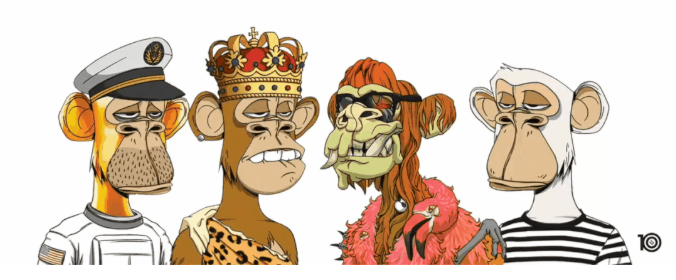
Web3 music projects also need strong IP promotion, and there are already a lot of music celebrities involved, such as the well-known rapper Snoop Dogg, pop queen Whitney Houston, etc., have released digital music based on NFT, and Hu Yanbin, a well-known domestic singer, also released a digital music collection album called "Monk" with Tencent Music.
In addition to music celebrities, traditional record companies have also begun to test the waters in the NFT field. In November 2021, Universal Music announced the launch of the Bored Ape band Kingship.
The user base is currently the biggest challenge for Web3 music products. In addition to waiting for the further growth of the population in the encrypted world and ushering in a richer user group in addition to financial investment, the active promotion of music celebrities or institutions may be the main source of the rapid increase in the number of users.
3.2. Technical preparation: L1 public chain and distributed storage
Compared with the user level, the technical preparation of Web3 music is relatively mature. The size of a song is basically 5-6M. At present, Layer1 public chain + distributed storage AR and IPFS/FIL can fully support it. In terms of user experience, there is no obvious difference from WEB2 applications in playback and audition, but only paid Most links only support encrypted asset payments. However, with the rapid promotion of encrypted currency payment, there are more and more middlemen for encrypted assets and fiat currency payment. In the future, there will be no problem for listeners to directly purchase NFT songs with fiat currency.
3.3. Community concept: DAO experiment of fan community and redistribution of value
Well-known entrepreneur and investor Peter Thiel talked about in "From 0 to 1" that in order for users to cross the two thresholds of habit and trust and choose a brand new product, the experience of this product needs to be "better than the original product". 10 times". Although for musicians, they have sufficient motivation to participate in Web3 music experiments, but for most users, unless Web3 music products can provide functions that are not available in current Web2 products and are difficult to replicate, otherwise they will not change. usage habit.
So, do music users care about obtaining the "ownership" of songs, and turn music from the streaming media listening mode to the NFT collection mode? Maybe not.
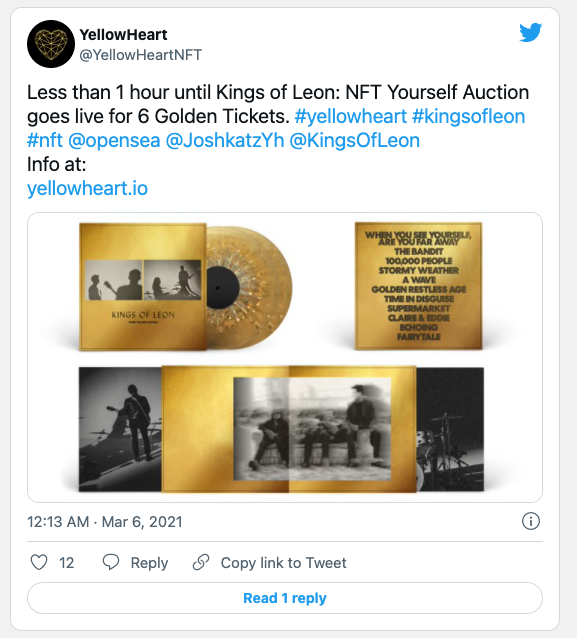
According to the report of the International Federation of the Phonographic Industry (IPFI), among the music revenue in 2020, music payment from online listening increased by 19.9% year-on-year, while paid download revenue fell by 15.7% year-on-year. The performance income is still large. The migration of users' music consumption habits from the "owning mode" of downloading to devices to the "accessing mode" promoted by music platforms is the general trend. Of course, unless the music NFT itself can provide added value other than "listening", for example, the American rock band Kings of Leon released a new NFT album called "When You See Yourself" on March 5 last year. A band that releases an album as an NFT. The music NFT issued by it has a "golden ticket". This NFT is equivalent to a lifetime VIP treatment. The owner will have the right to guarantee four front-row seats to watch any Kings of Leon concert for life. These include a personal driver, show concierge, private pre-show meetups with the band, exclusive lounge access, and a merchandise booth at each show. However, it is conceivable that this customized service is not a zero marginal cost service like streaming music, and cannot be provided to most people.
image description
Limited Edition "Golden Ticket" NFT Released by Kings of Leon
In the author's opinion, for users of music NFT, the real service value of upgrading may start from the redistribution of "community\DAO authority" and music value.
As a distributed, co-constructed and shared new organizational form, DAO is naturally suitable for fan groups of musicians. In fact, many artist fan groups are already operating as part of DAO, and the emphasis on contribution and "generating electricity with love" also coincides with part of DAO's philosophy. However, problems such as fund-raising management, information opacity, confusion in the distribution of responsibilities, and core personnel losing fans cause organizational downtime to occur from time to time. The introduction of NFT, smart contracts and DAO governance tools can effectively improve the above problems.
More importantly, having a specific music NFT may become an exclusive voucher for fans to enter a musician's DAO. The accumulation, combination and use of music NFTs have a wide range of scenarios in DAO organizations.
For generation Z, who have a high degree of acceptance of new things and a strong pursuit of belonging and self-identity, entering, participating in and co-building a DAO organization that they love idols will surely provide more than "collecting a Ta" song" or "go to her concert". For DAO organizations, the introduction of NFT will also improve the efficiency of verification and management. As long as the introduction and co-construction rules of the DAO community are well established, more new users will join and become active, and it will also stimulate new students that are currently unimaginable. machine, this new life may give birth to a new music service.
Therefore, in the next 1-2 years, whether there will be an organization of musicians and fans based on the Web3 paradigm, and whether there will be a new way of mobilizing a huge number of users in the value distribution of music NFT will be to observe whether the Web3 music industry is coming. important events.
In summary, if the Web3 music track is to usher in an east wind similar to the summer of DeFi in 2020, it may need to meet a series of preconditions, including sufficient user levels, technical preparations, and the full practice of the DAO concept in the music industry. This will be an element that we need to focus on in the future.
first level title
4. The explosion path of the Web3 music track
Looking back at the relatively successful track in the encrypted business field in recent years, with a certain number of users and a long life cycle, one is the DeFi that began to rise in 2020, and the other is the avatar-like NFT that began to become popular in 2021 and went out of the circle. If the Web3 music track explodes, which of the above paths will it take?
PS: The chain game projects that are also very popular in 2021 have been analyzed by the author in the previous article. At present, their financial attributes are far greater than the game attributes. They are essentially a gamified variant of Ponzi finance and still belong to the DeFi category.
4.1. DeFi path
DeFi projects have existed before 2020, but its real first year is 2020. The very important reason is the emergence of the "liquidity mining" model, which solved the two big mountains in front of DeFi:
How to find initial users and funding, complete the cold start of the project
It is expensive to list on a large centralized exchange, and if it is not listed, the project token has no liquidity
The novel model of liquidity mining solved the above two problems at the time, and formed a strong and lasting wave of "decentralized finance swallowing the world" market narrative, allowing many DeFi projects to enter: token price rise → liquidity mining Mining APR rises further → Core business indicators rise → Positive business flywheel of token price rise.
Coupled with the natural financial needs of encrypted users, DeFi has actually accumulated a large number of real users, and its commercial value has been verified so far.
Of course, liquidity mining also has the Ponzi color of "stepping on the left foot to the sky". When the narrative trend of the entire market turns and the funds flowing into the project are insufficient, the positive business flywheel mentioned above will be interrupted. Most projects will enter a death spiral of: currency price drop → APR drop → capital outflows lead to deterioration of core indicators → further decline in currency prices.
4.2. Avatar NFT path
If DeFi projects are taking the path of "liquidity mining driving fundamentals", then avatar NFTs are taking a completely different path, the core of which is Meme culture + social currency.
text
4.2.1. Meme culture
A typical Meme sample is Pepe the Frog.
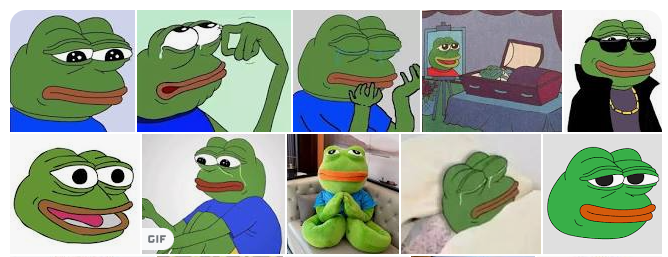
This Meme originated from the series of heavy-duty comics "Boy's Club" created by cartoonist Matt Furie in 2005. Among the several characters in the comics, there is Pepe. In the comics, Pepe is a happy frog who pees and takes his pants down to his ankles. When someone asked why it did this, it replied: "Because it feels good man." On January 22, 2009, the image of Pepe was put on the website 4chan by netizens. On the basis of the original, a second creation was carried out, and its originally upturned mouth was adjusted in one direction, and then the Sad Frog (Feels Bad Man, Sad Frog), which became popular all over the world, was born.
Pepe, which originated from a comic in 2005, has been popular for 17 years, which shows the vitality of Meme. Image source: Google
Among the well-known NFT avatars, whether it is the pixel-style CryptoPunk or the hippie-style BAYC (boring ape), its elements are all in the same line as those classic samples in the Meme culture: most of them are created by grassroots or anonymous people, and the shape is simple and easy to secondary Creation and dissemination, with a distinct subcultural temperament. Among them, BAYC's derivative cooperation and secondary creation with other groups are particularly rich and active. Meme is a kind of consensus, and it is also a kind of Internet mass culture that can self-replicate and grow iteratively. It is the expectations of users and investors based on the value of NFT avatar Meme that constitute the first layer of value connotation of avatar NFT.
text
4.2.2. Social currency
- The special feature of the avatar NFT is that its main scene is to display to the external social circle.
- This gives it 2 huge advantages over other NFTs:
Has the strongest and most extensive free dissemination effect. Everyone who puts on the NFT avatar on social media has become a free, long-term billboard for the NFT series. The social circle covered by Ta will see this "advertisement" every day. If the avatar owner is an influential person in a certain field (such as entertainer, sports star, business tycoon), it will further trigger the imitation and following of those who recognize their identity, which will bring buying to the NFT and form scarcity.
When the price of the NFT reaches a certain level, the NFT avatar will become a typical "Veblen product" with luxury features similar to Hermes. The main utility of Veblen goods is to show off, and this showy utility will further increase as its price rises. In the Internet age, the avatar is the most exposed personal symbol, which makes the expensive NFT avatar a Hermès platinum bag or a limited edition Ferrari sports car in the encrypted world.
Due to the above characteristics, avatar NFTs are born with strong social currency attributes.
Meme + social currency has achieved the powerful wealth effect of avatar NFT, and the social currency attribute plays a greater role in it.
4.3. Explosion Path of Web3 Music
There are currently two main types of value carriers in the Web3 music project:
Music applications, such as music NFT distribution and trading platforms;
The music NFT itself.
So, what path will the Web3 music project take to explode? Is it a business flywheel model like DeFi, or is it a Meme+ social currency model like an NFT that will bring music NFTs on fire, and then promote the development of music platforms?
In my opinion, the former is more likely.
It is quite difficult for music NFTs to usher in a capital explosion on the scale of avatar NFTs. the reason is:
The current scene of music NFT mainly lies in listening and collection, and the display scene is weak, showing off is far less than that of avatar NFT, and the attribute of social currency is not strong
Although there are many meme samples in the music industry, such as the Korean song "Gangnam Style" that was once popular all over the world, the electronic dance music of black people carrying coffins, and the popular "Wild Wolf Disco" in China, etc., their life cycle is shorter than that of picture memes. Much more, the difficulty of secondary creation and dissemination is also greater
Compared with the popularity of music NFTs reproducing avatar NFTs, the rise of Web music platforms is more likely because it has a clearer business growth path, such as:
P side: Web3 music platform can attract its users to join by cooperating with world-renowned musicians. Of course, musicians can also build their own platforms
Industry side: Web3 music platform can cooperate with well-known record companies and music platforms to obtain copyrights and users. Similarly, record companies and Web2 music platforms can also build their own platforms
Among them, the resources of musicians and industry are important, but whoever can design an appropriate economic mechanism and turn the business flywheel as soon as possible will be the early winner of the Web3 music platform.
Just like the highly concentrated online music market in the Web2 field and the highly concentrated NFT trading platform, the Web3 music platform does not need too many small and medium players in the long run. Whoever can grow rapidly at the earliest will likely siphon most users and musicians, forming a competitive advantage that is difficult to surpass.
5. Capture investment opportunities in the Web3 music track
5.1. From the perspective of investment opportunities, the author believes that the following points need attention.
text
The technical conditions of the Web3 music track are relatively mature, but it will take time for users and community concepts to mature. A large amount of investment in this track too early may on the one hand result in higher capital costs; on the other hand, the earlier the industry is, the more difficult it will be to select the project that will eventually emerge. When we find that a large number of well-known and musicians, music organizations or music platforms have entered the market, and have produced good user introduction effects, and DAO organizations have become an important form of music fan communities, and the value distribution method of the industry is gradually undergoing innovation. Maybe it's a better time to focus.
5.2. Give priority to projects that have high-quality industrial resources and are familiar with the design of encryption mechanisms
As mentioned in Chapter 4, the IP resources of the industry and musicians are very important, but what is more important is that the project party has excellent design capabilities for the token model and product mechanism of the encryption project, and is familiar with the gameplay of the encryption business, rather than through the at-hand A resource for moving the Web2 paradigm hard into the crypto world. In addition, the project party must have sufficient funds and determination to quickly expand the bilateral music supply and demand market at the beginning, and promote the rotation of the business flywheel as soon as possible. Gala, a well-known Web3 game platform project, recently announced its preliminary plan to enter the Web3 music market. Among the few revealed designs, it mentioned node bidding, Listen to earn and other gameplay, as well as a $1 billion industry incentive budget. In addition, heavyweight musicians such as Snoop Dogg will be invited to join in advance, which may become one of the samples of high-quality industrial resources + excellent encryption mechanism design.
5.3. The ceiling of Web3 music is different from that of DeFi, and the project valuation should be cautious
From the perspective of market size, there is a big gap between the music market with a revenue scale of 20 billion US dollars and the trillion-level financial market, and there is still a competitive relationship between music and games, social networking and other tracks to compete for user time. Web3 Music The ceiling of the industry scale is far lower than that of DeFi. Judging from the valuation of the company, Spotify, the global online music giant with the largest number of paying users, has a total market value of about 30 billion US dollars, and China’s Top 1 Tencent Music has a total market value of around 9 billion US dollars. Universal Music holds the largest number of high-quality record copyrights. The market value of the group is about 41 billion US dollars (36.5 billion euros). At present, Audius, the most valuable and most representative Web3 music project, has a total valuation of nearly 900 million U.S. dollars in fully diluted tokens. Under the condition that the market and user scale are far from mature, in the bear market The valuation of the project is already not low.
IFPI:Global music report 2021
Here's How NFTs Could Define The Future Of Music
The next big trend in NFTs
Web3 music is one of Mint Ventures' long-term attention tracks. The above superficial views are for reference only and should not be used as investment advice. Welcome Web3 entrepreneurs to communicate and discuss with us.
Communication University of China: Chinese Musician Report 2021
Over 71 million online music paying users, TME pushes the flywheel of the music industry



